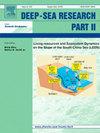Distribution and drivers of phytoplankton biomass along the Saya de Malha Bank in the Western Indian Ocean
IF 3
3区 地球科学
Q2 OCEANOGRAPHY
Deep-sea Research Part Ii-topical Studies in Oceanography
Pub Date : 2025-03-31
DOI:10.1016/j.dsr2.2025.105480
引用次数: 0
Abstract
The Saya de Malha bank found in the Western Indian Ocean is known as a key biodiversity area with high productivity. In-situ data, however, is characterised by paucity, therefore the Indian Ocean 2022 mission of the Monaco Explorations provided an opportunity to assess the productivity and investigate the major drivers of the phytoplankton community across this bank. The main findings on phytoplankton indicated a well-mixed water column across the bank, with some spatial differences observed in total chlorophyll-a, and the relative abundance of the pico-, nano- and microplankton. Based on the total chlorophyll-a, higher pelagic productivity was found on the shelf in the north-eastern section of the bank, decreasing towards the south. Size distribution of phytoplankton biomass indicated that the communities of the bank were dominated by pico-phytoplankton (∼46 %), and that highest relative abundance of this group was encountered in the surface waters. Conversely, the micro-phytoplankton had low relative abundance in the surface water (∼13 % at <60 m), increasing towards deeper waters (∼36 % at >60 m). Comparison of the phytoplankton biomass with Acoustic Doppler Current Profiler (ADCP) data obtained during this expedition shows a strong alignment between maximum biomass and dominant current velocities at 30 m depth across the bank, and therefore can be used to inform the likely export patterns of biomass towards the rest of the Western Indian Ocean and the contribution of the Saya de Malha bank as a carbon sink and a carbon exporter to the rest of the pelagic trophic web in the region.
西印度洋Saya de Malha岸浮游植物生物量分布及其驱动因素
在西印度洋发现的Saya de Malha银行被称为具有高生产力的关键生物多样性地区。然而,现场数据的特点是缺乏,因此摩纳哥勘探公司的2022年印度洋任务提供了一个评估生产力和调查该河岸浮游植物群落主要驱动因素的机会。浮游植物的主要研究结果表明,整个河岸的水体混合良好,总叶绿素-a和微、纳米浮游生物的相对丰度存在一定的空间差异。从总叶绿素a的角度看,北岸东北段陆架的远洋生产力较高,向南逐渐降低。浮游植物生物量的大小分布表明,该河岸的群落以微型浮游植物为主(约46%),该类群的相对丰度在地表水中最高。相反,微型浮游植物在地表水中的相对丰度较低(60米处约13%),在更深的水域中增加(60米处约36%)。将这次考察期间获得的浮游植物生物量与声学多普勒洋流剖面仪(ADCP)数据进行比较,发现在30米深度的最大生物量与主导流速之间存在强烈的一致性。因此,可以用来了解向西印度洋其他地区输出生物量的可能模式,以及Saya de Malha银行作为碳汇和碳出口国对该地区其他中上层营养网的贡献。
本文章由计算机程序翻译,如有差异,请以英文原文为准。
求助全文
约1分钟内获得全文
求助全文
来源期刊
CiteScore
6.40
自引率
16.70%
发文量
115
审稿时长
3 months
期刊介绍:
Deep-Sea Research Part II: Topical Studies in Oceanography publishes topical issues from the many international and interdisciplinary projects which are undertaken in oceanography. Besides these special issues from projects, the journal publishes collections of papers presented at conferences. The special issues regularly have electronic annexes of non-text material (numerical data, images, images, video, etc.) which are published with the special issues in ScienceDirect. Deep-Sea Research Part II was split off as a separate journal devoted to topical issues in 1993. Its companion journal Deep-Sea Research Part I: Oceanographic Research Papers, publishes the regular research papers in this area.

 求助内容:
求助内容: 应助结果提醒方式:
应助结果提醒方式:


